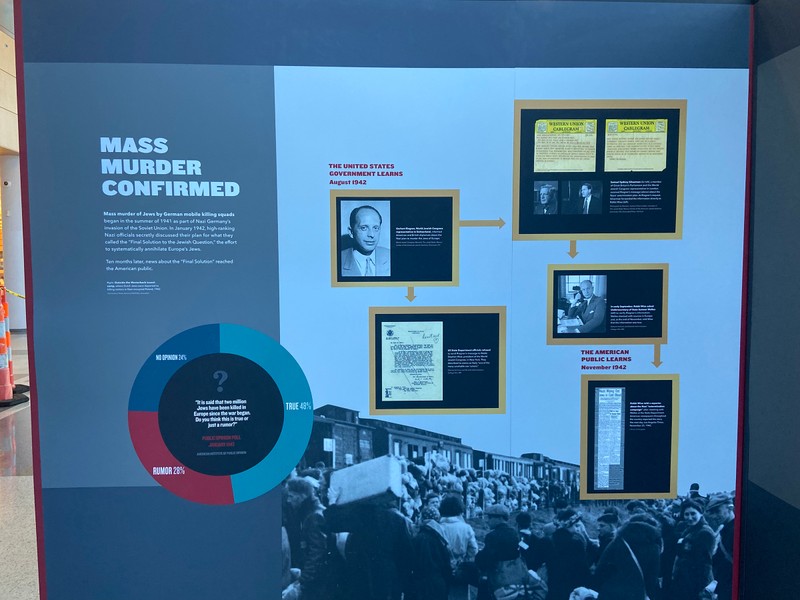Mass Murder Confirmed (Americans and the Holocaust)
Introduction
Author-Uploaded Audio
Mass Murder Confirmed (Americans and the Holocaust)
Text-to-speech Audio
The final section of the exhibition explores how Americans responded to the Holocaust. In November 1942, Americans learned for the first time that Nazi Germany had a plan to murder all the Jews in Europe. If you go back to the newspaper kiosk we looked at a few minutes ago, you can see some of the nationwide coverage of this announcement. But that news reached the United States in a roundabout way. This man, Gerhart Riegner, learned about the Nazi plan in August 1942. At first, the State Department blocked the message, writing that it was likely a war rumor. But the news eventually got to Rabbi Stephen Wise, one of the most influential rabbis in America. He asked the State Department to investigate and confirm the information. By November 1942, they did, and newspapers across the country printed stories informing Americans that Nazi Germany was murdering millions of European Jews.
Of course, November 1942 is almost a year after Pearl Harbor. The United States was at war with Nazi Germany but could not reach Nazi controlled territory, where the murders were taking place. On this kiosk is a film that shows the progress of World War II--where the Allied soldiers were, and where the Nazi killing centers were located. What you see in the film is that by the time American soldiers landed in France during the D-Day invasion in June 1944, more than five million Jews had already been killed.
Images
Mass Murder Confirmed panel (Americans and the Holocaust)

Backstory and Context
Text-to-speech Audio
Metropolitan Library System is one of 50 U.S. libraries selected to host AMERICANS AND THE HOLOCAUST, a traveling exhibition from the U.S. Holocaust Memorial Museum that examines the motives, pressures, and fears that shaped Americans’ responses to Nazism, war, and genocide in Europe during the 1930s and 1940s.
The Americans and the Holocaust exhibit will be on display at the Downtown Library, along with a series of related special events from Thursday, January 5 to Sunday, February 12.
Based on extensive new research of that period, Americans and the Holocaust addresses important themes in American history, exploring the many factors — including the Great Depression, isolationism, xenophobia, racism, and antisemitism — that influenced decisions made by the U.S. government, the news media, organizations and individuals as they responded to Nazism. This exhibition will challenge the commonly held assumptions that Americans knew little and did nothing about the Nazi persecution and murder of Jews as the Holocaust unfolded.
Drawing on a remarkable collection of primary sources from the 1930s and ’40s, the exhibition focuses on the stories of individuals and groups of Americans who took action in response to Nazism. It will challenge visitors to consider the responsibilities and obstacles faced by individuals — from Franklin Delano Roosevelt to ordinary Americans — who made difficult choices, sought to effect change, and, in a few cases, took significant risks to help victims of Nazism even as rescue never became a government priority.
Americans and the Holocaust was made possible by the generous support of lead sponsor Jeannie & Jonathan Lavine. Additional major funding was provided by the Bildners — Joan & Allen z”l, Elisa Spungen & Rob, Nancy & Jim; and Jane and Daniel Och. The Museum's exhibitions are also supported by the Lester Robbins and Sheila Johnson Robbins Traveling and Special Exhibitions Fund, established in 1990.
Sources
United States Holocaust Memorial Museum. Accessed January 5th, 2023. https://www.ushmm.org/.
American Library Association. Accessed January 5th, 2023. https://www.ala.org/.
